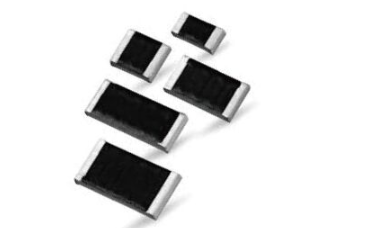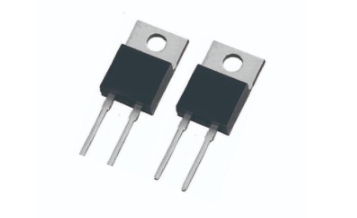Position:Home » Technical Articles
Thick film resistors' and Thin Film Resistors' Technology, Feature and Applicaiton
Writer:Microhm Page View:Date:2019-05-10
Thick film resistors and thin film resistor , the most common types in the market, are characterized by a resistive layer on a ceramic base.
Thick film resistor started to gain popularity In the 1970s. Today, these are by far the most used resistors in electrical and electronic devices. They come usually as chip resistor (SMD), and have the lowest cost compared to any other technology.

The temperature coefficient of thick film resistor typically ranges from 50 ppm to 200 ppm/K. Tolerances are between 1% and 5%. Because costs are low, thick film is generally preferred in case no high tolerances, low TCR or high stability is required. Therefore, these resistors can be found in almost any device with an AC plug or a battery. Advantages of thick over thin technology are not only lower cost, but also the ability to handle more power, provide a wider range of resistance values and withstand high surge conditions.
The resistive layer of thin film resistor is sputtered onto a ceramic base. This creates a uniform metallic film of around 0.1 micrometer thick. Often an alloy of Nickel and Chromium is used. They are produced with different layer thicknesses to accommodate a range of resistance values. The layer is dense and uniform, which makes is suitable to trim the resistance value by a subtractive process. With photo etching or by laser trimming patterns are created to increase the resistive path and to calibrate the resistance value. The base is often alumina ceramic, silicon or glass. Usually thin film is produced as a chip or smd resistor, but the film can also be applied onto a cylindrical base with axial leads. In this case, more often the term metal film resistor is used.

Thin film is usually used for precision applications. Typical examples where thin film is used are medical equipment, audio installations, precision controls and measurement devices.
They feature relatively high tolerances, low temperature coefficients and low noise. Also for high frequency applications thin film performs better than thick film. Inductance and capacitance are generally lower. The parasitic inductance of thin film can be higher if it is executed as a cylindrical helix (metal film resistor). This higher performance comes with a cost, which can be factors higher than the price of thick film resistors.
Thick film resistor started to gain popularity In the 1970s. Today, these are by far the most used resistors in electrical and electronic devices. They come usually as chip resistor (SMD), and have the lowest cost compared to any other technology.

The temperature coefficient of thick film resistor typically ranges from 50 ppm to 200 ppm/K. Tolerances are between 1% and 5%. Because costs are low, thick film is generally preferred in case no high tolerances, low TCR or high stability is required. Therefore, these resistors can be found in almost any device with an AC plug or a battery. Advantages of thick over thin technology are not only lower cost, but also the ability to handle more power, provide a wider range of resistance values and withstand high surge conditions.
The resistive layer of thin film resistor is sputtered onto a ceramic base. This creates a uniform metallic film of around 0.1 micrometer thick. Often an alloy of Nickel and Chromium is used. They are produced with different layer thicknesses to accommodate a range of resistance values. The layer is dense and uniform, which makes is suitable to trim the resistance value by a subtractive process. With photo etching or by laser trimming patterns are created to increase the resistive path and to calibrate the resistance value. The base is often alumina ceramic, silicon or glass. Usually thin film is produced as a chip or smd resistor, but the film can also be applied onto a cylindrical base with axial leads. In this case, more often the term metal film resistor is used.

Thin film is usually used for precision applications. Typical examples where thin film is used are medical equipment, audio installations, precision controls and measurement devices.
They feature relatively high tolerances, low temperature coefficients and low noise. Also for high frequency applications thin film performs better than thick film. Inductance and capacitance are generally lower. The parasitic inductance of thin film can be higher if it is executed as a cylindrical helix (metal film resistor). This higher performance comes with a cost, which can be factors higher than the price of thick film resistors.
Keywords:
Latest News
- Resistor's role in measuring and correcting LED,,,
- Single through-hole resistors' characteristics ,,,
- Why shunt resistors for current sense applicati,,,
- Metal-film resistors with small size, high resi,,,
- 36W High-Current Shunt Resistors MMS8420,,,
- 1W Surface Mount Resistor MPR1206,,,
- An Overview of Microhm Electronics' Resistor Pr,,,
- More anti-sulfur resistors used in harsh envir,,,
- Resistance changes with temperature,,,
- 140W TO247 High Power Heatsinkable Resistor,,,
- MMS5930 is ideal for current sensing in industr,,,
- Shunt resistors selection for engineers' design,,,
- Considerations for choosing precision resistors,,,
- Ceramic Encased Cement Resistors NWH Series for,,,
- Resistors for Passive Balancing in Battery-Pow,,,
Hot Articles
- Microhm will take part in 10th Automotive World,,,
- Thanks for Visiting Microhm's Booth E5-5706 in ,,,
- Resistors in Short Supply: Blame Cars,,,
- New lunch: High Power Precision Shunt Resistor,,,,
- How to Test a Resistor,,,
- Innovative Technology, Future Electric: Electri,,,
- What is Precision Resistors?,,,
- SMD Resistors Sizes and Packages,,,
- The Construction and Features of Metal Film Res,,,
- What is a TO-220 Resisor?,,,
- Hot Selling Products: Precision Shunt Resistors,,,
- How to Calculate the Equivalent Resistance Valu,,,
- What is a Fixed Resistor?,,,
- Resistors in LED Circuits,,,
- Resistors Types and Materials Overview,,,
Resistance applications
- Precision Resistors' Construction and TCR,,,
- Heater Blower Motor Resistor in Air Conditioner,,,
- Why Zero-Ohm Resistors?,,,
- Difference Between High Precision Resistors and,,,
- Select the Right Resistor for Harmonic Filterin,,,
- BMS for New Energy Vehicle,,,
- The Measurement Accuracy of Automotive Shunt is,,,
- Industrial Roberts Applied to Solar Photovoltai,,,
- Shunt Resistor MMS8420 for High Current Stable ,,,
- Surface Mount Resistor's Size and Package ,,,
- Carbon Film Resistors' Features and Application,,,
- Urbanization Development Bringing the Transform,,,
- The Main Application for High Precision and Low,,,
- The Four Important Functions of Alloy Resistors,,,
- Miniature future for passive electronic compone,,,
